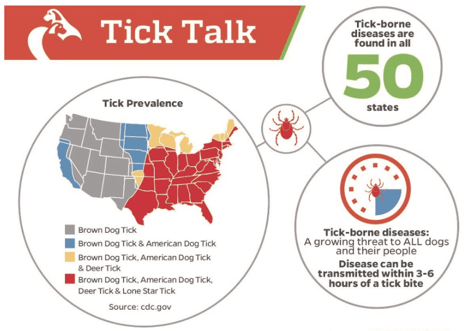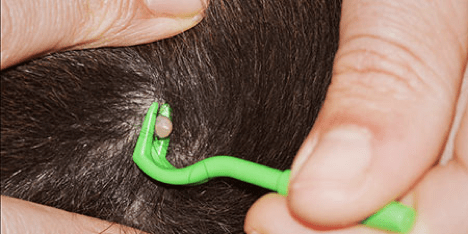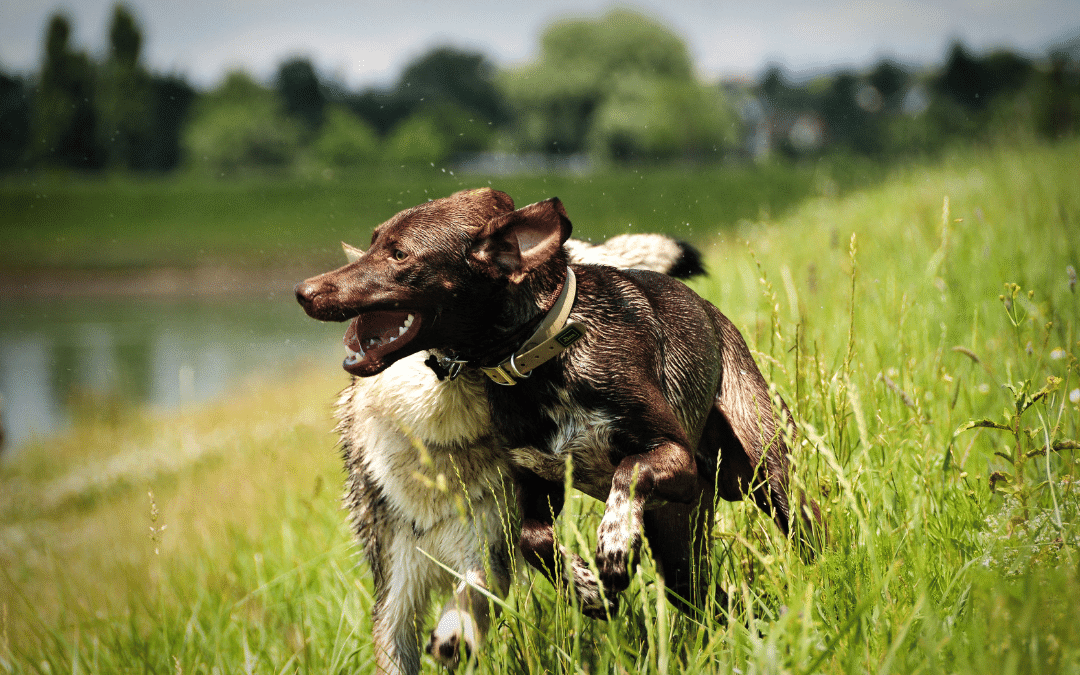Warmer weather brings beautiful flowers, budding trees, and chirping birds. It also brings unwanted bugs like mosquitoes, fleas, and ticks. But what if you aren’t sure what a tick looks like or how to remove it if you find one on your dog? They might be small, but they can cause big problems for your pup.
Many different species of the tiny arachnids are found all over the globe, but only a few of them bite and transmit diseases. Georgia is home to at least five of them, according to the Federal Centers for Disease Control and Prevention: American Dog tick, Blacklegged tick (also known as a Deer tick), Brown Dog tick, Gulf Coast tick (rare in Atlanta), and the Lone Star tick.

Ticks can be dangerous if they are not removed immediately. Ticks feed on blood. When one of them bites your dog, it can pass on illnesses like Lyme Disease and Rocky Mountain spotted fever. Both can cause stiffness, joint pain, and other health problems.
It takes a tick anywhere from 3 to 24 hours of feeding to infect an animal. But if you know how to find and remove them early, you can lower the chances of your dog getting sick. You can also make sure they don’t bring one of these pests into your home, where it could attach itself to you and make you ill.
How to Check Your Dog for Ticks
Give them a once-over before you go inside, or just inside the door, to lower the chance that a tick will get into your home.
Comb through their fur with your fingers. Press gently so you can feel any bumps on the skin. Ticks can be as small as a pinhead or as big as a grape. Don’t forget to check their feet (including between their toes), inside their ears, and around the face and neck.
If you find a bump, part your dog’s fur so you can see their skin. Look for a black, brown, or grayish-brown bug. You might only see the tick’s body, or you might see its legs, too.
Removing a Tick from Your Dog
Using a pair of tweezers is the most common and effective way to remove a tick. But not just any tweezers will work. Most household tweezers have large, blunt tips. You should use fine-point tweezers, to avoid tearing the tick and spreading possible infections into the bite area.
Spread your dog’s fur, then grasp the tick as close to the skin as possible. Very gently, pull straight upward, in a slow, steady motion. This will prevent the tick’s mouth from breaking off and remaining embedded in the skin. People often believe it’s the head of the tick that embeds in the skin. But ticks don’t have heads, in the conventional sense, so what gets inserted into your dog is known as “mouth parts.”
Another option that is even easier to master is the use of a tick removal hook. It’s especially useful if you live in a tick-dense area where your dog is frequently playing host to the vexing little critters. There are several types of hooks, like the Tick Twister or the Tick Stick. You simply put the prongs on either side of the tick and twist upward.

Never remove a tick with your fingers – it’s not only ineffective, but the squeezing may also further inject infectious material.
After you’ve removed the tick, make sure to wash your hands thoroughly, clean the bite site with rubbing alcohol, and rinse the tweezers or tool with disinfectant.
If you aren’t sure you can remove a tick call your vet. You can take your dog in, and they or a vet tech will remove it for you. Plus, they can show you how, so you can take off the next one yourself. Your vet will also be able to help you find the best and most effective tick prevention product for your dog. There are topical treatments, collars, and shampoos; each made to address specific needs. If infestation is bad enough, or in parts of the country where fleas are on the ground, professional exterminators may be needed.
Here’s hoping it doesn’t come to that, and that everyone gets to enjoy the great Spring weather!
More Village Barker

How to Prevent Fleas
Flea prevention is an essential part of maintaining the health and well-being of dogs. Fleas are external parasites that can cause various problems, such as itching, skin irritation, and even...

Twelve Amazing Facts about Dogs
Dogs communicate through body language: Dogs use various body language cues to communicate their feelings and intentions. Tail wagging, ear position, facial expressions, and body posture are...

